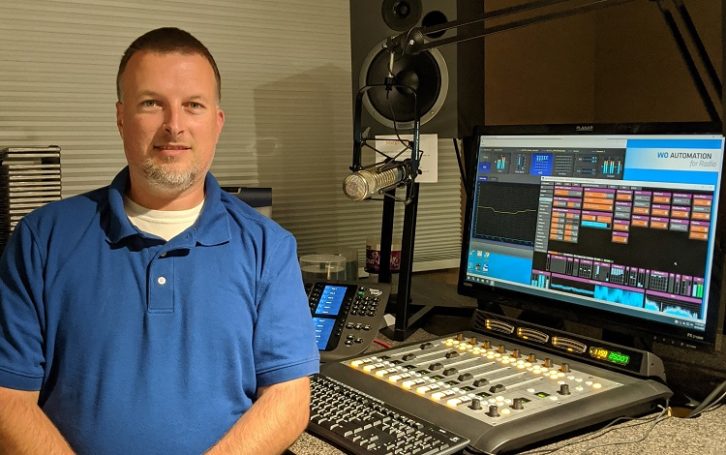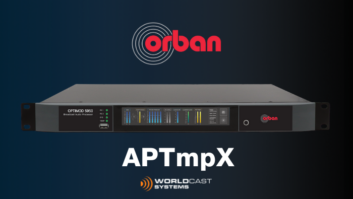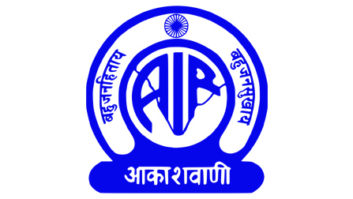
Matt Levin is chief engineer for River Radio in Columbus, Ohio, and does contract engineering for several stations. Our interview with him is from the Radio World ebook “Trends in Audio Processing for Radio.”
Radio World: We’re asking users and manufacturers for their take on key trends in processing.
Matt Levin: I think the biggest development in processing is the shift from conventional dedicated hardware boxes to software that can run on a server with an alternative method for the MPX audio to get to the transmitter.
By shifting to software, it allows you to do your processing on your own server hardware, either on a physical box or in a virtual machine, or in the cloud via hosted services. Virtualization is the direction pure IT infrastructure went years ago and now the radio industry is finally embracing this concept from automation vendors to now processing vendors.
One of the keys to allowing this to work fully was the invention of the MicroMPX codec by Hans van Zutphen and his employee Mathijs Vos, and now through their collaboration with the Telos Alliance, we’re seeing products employing this technology. We are seeing further innovation by Telos and Nautel to synchronize the HD Radio and FM audio across the internet, which was the last major problem to solve before this becomes the norm for processing moving forward.
The other major benefit to this model is that it brings the cost of good processing capability down, as there is no expensive hardware box to design, build, maintain and support by the manufacturers. It’s just a server that most IT savvy engineers can maintain on their own, so really it’s a win-win for everyone!
RW: What should we know about differences in processing for various types of platform?
Levin: The needs are very different.
The worst thing an engineer could do would be to take the OTA FM signal and feed it into a web encoder. Low-bitrate webstream encoders do not deal well with a lot of density, or clipping, both of which are employed for FM OTA.
For FM OTA processing we are trying to overcome both the inherent noise in the FM analog broadcast system, and the road noise in automobiles, as studies have proven that most FM OTA listening is done while driving. Even with FM HD OTA we want some density there to overcome the road noise I spoke of, although you obviously don’t want all the clipping designed for the FM analog system.
Streaming in my opinion always needs its own separate processing which uses gentle, low-ratio compression, mainly for consistency between each piece of audio, and with some light lookahead limiting for peak protection on the encoder.
The other thing I’ve discovered through my own experience with low-bitrate webstream encoders, both MP3 and HE-AAC, is that they don’t deal well with excessive stereo enhancing or excessive warm bass/low mid-range material.
This seems to muddy everything in the codec, and too much stereo energy also causes havoc in the encoder, so careful shaping of the audio to pull some of the muddy area out, and use of very light spatial enhancing should be employed here.
Since podcasts deal primarily with speech, but are still typically low-bitrate-encoded audio files, the same rules apply from my previous streaming comments with the added aspect to keep the voice region clean, intelligible, and consistent.
RW: With “hybrid” platforms, a listener might tune to an FM but then drive out of market and the receiver switches to the online stream. What “matching” challenges does this present?
Levin: As this technology becomes more prevalent, paying attention to your web stream processing becomes more and more important, as it won’t just be in homes and offices anymore, but now in cars as well and for the masses.
This is where creating your “sonic signature” on both your OTA and your stream is so important. While the needs of processing for streaming differ greatly, you can still create a certain “sound” for your station that stays consistent on all platforms.
Take the time to listen to your FM, HD and web stream and come up with something that sounds comparable on all platforms.
RW: Where might further dramatic improvements in processing power come from?
Levin: Unfortunately, I think the needs today are more about trying to repair the damage done to the music by poor mastering techniques used by the record labels, and/or the damage done by using lossy codecs in the distribution process. Processing has become more than just compression, limiting and clipping.
Modern processors of today also have to repair the audio before it ever hits the compression stages. Different manufacturers are finding different ways to do this; these tools aim either to declip and add dynamics to audio that the mastering process has over-processed and over-clipped, or restore missing spectrum and remove artifacts from lossy compression.
Those that implement these repair tools in their processors have a cleaner product going into the compression stages, and will end up with a much-better-sounding product on the output, and I think we will continue to see more of these kinds of tools.
Additionally, there has been effort put into preparing the output audio or processors feeding low-bitrate codecs (i.e. streaming or HD) to prevent artifacts from being generated in the codec itself; all in an effort to get the best sounding audio to the user.
RW: We’ve also been asking folks if radio processing has attained such a condition of “hypercompression” that there has been little further change in how loud one can make over-the-air audio.
Levin: I have actually seen a significant amount of development from several of the leading processor manufacturers to create cleaner and cleaner clipping structures. Each employs different techniques to do this, so each has different side effects, but as a whole, the loudness levels we are able to achieve today while still keeping the audio clean and free of clipping grunge, distortion, and artifacts out of the top boxes on the market is actually a huge improvement over the boxes of 10+ years ago.
Now, how the engineers are turning the knobs on these boxes at their individual stations is another story. I think in some cases engineers are still abusing even these modern clippers and driving them past the point of sounding good, and further damaging the end user experience by over modulating significantly, causing massive amounts of distortion in modern DSP receivers.
I’m finding as I travel that most modern DSP-based HD capable receivers start to induce distortion on anything over 110%, and while many markets and engineers stay below this and can maintain clean audio, there are others that choose to carelessly overmodulate by as much as 140%, and you can imagine how bad that can sound on a modern receivers.
As much effort as the manufacturers have put into cleaning up the audio and providing a better product for the end user, it’s still up to the engineer installing and setting up their air chain and processing to make sure that they are using the tools at their disposal to provide the best possible product to their listeners.
I remember a day when radio sounded better than the music you would buy and listen to on your own, when processing actually improved the sound. With the power of modern processors, this is still possible today, but so many markets I’ve driven through recently this is sadly not the case. I long for the day when we as an industry strive for that goal once again, to sound better than the other streaming services and listening options out there.
RW: Could radio see loss of potential audience due to listening fatigue?
Levin: We as an industry are driving listeners away by bad practices, not only by overcompression, overclipping and overmodulating, but let’s add overusing Voltair to that list as well. I’ve traveled to some markets where all I hear is PPM tones adding flange effect and reverb effect to everything going over the air.
We have to do a better job of caring what our product sounds like if we hope to stay relevant in the future. Now sure, there may be some listeners out there who don’t care; but there are a lot that do.
While they may not be able to tell you why they can’t stand to listen to a particular radio station for more than a few songs or a few minutes before it drives them crazy or makes them want to turn the volume down, I wager that if you had the same content on a much cleaner-sounding delivery system, they would suddenly find it much less annoying and actually find themselves turning the volume up, instead of down or off.
Give listeners a reason to turn the volume up, make your station sound good!
Comment on this or any article. Email [email protected] with “Letter to the Editor” in the subject field.












